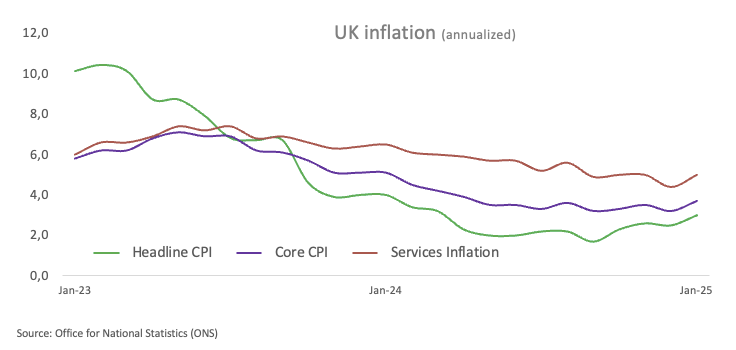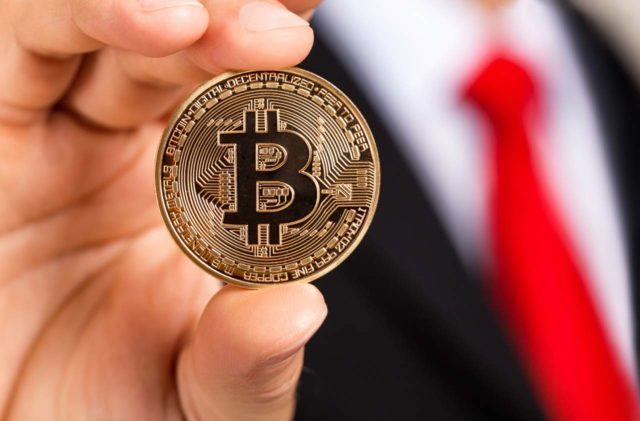- The Bank of England is expected to maintain its interest rate in 4.50%.
- The inflation figures of the United Kingdom remain well above the target of the BOE.
- The GBP/USD extends its rally beyond the 1.3000 psychological barrier.
The Bank of England (BOE) is ready to reveal its monetary policy decision on Thursday, marking the second meeting of 2025.
The expectations are high among the market observers that the Central Bank will maintain its reference rate by 4.50%, after a reduction of 25 basic points the previous month.
Together with the decision, the BOE will publish the minutes of the meeting, and Governor Andrew Bailey will hold a press conference to clarify the reasons behind the measure.
Unless there are surprises in the decision on the interest rate, all eyes will focus on the future orientation of the bank and on economic perspectives.
United Kingdom Economic Perspectives: Persistent Inflation, Growth In Decrease
The Bank of England (BOE) complied with expectations in February, making a hard -line rate cut unanimously backed by the nine members of the Monetary Policy Committee (MPC).
Meanwhile, new data from the National Statistics Office (ONS) revealed an unexpected increase in the annual general inflation of the United Kingdom, which rose to 3.0% in January from 2.5% in December. The underlying inflation, which excludes food and energy costs, also increased, reaching 3.7% in the last 12 months.
In addition, growth figures painted a less optimistic picture. The Gross Domestic Product (GDP) of the United Kingdom contracted unexpectedly 0.1% in January. In addition, negative industrial and manufacturing production data also contributed to the gloomy image, while the Global S&P manufacturing PME remained stagnant in contraction territory during the same month.
After these discouraging figures, the swap market now provides for around 56 basic states of relief by the BOE until the end of the year.
In the last monetary policy meeting of the BOE, Governor Andrew Bailey explained that global economic uncertainty played a key role in the decision to add the word “careful” to future orientation on the bank’s interest rates.
At a press conference, he commented that this uncertainty was “bidirectional”, suggesting that he could hinder the disinflation process or, on the contrary, accelerate it.
“It could lead to conditions that, in fact, make the path of disinflation less safe,” Bailey said, before adding that “frankly it could also … lead to conditions that have the opposite effect and lead to a faster path for deflation.”
How will the BOE to GBP/USD interest rates impact?
As mentioned above, investors widely anticipate that the BOE will maintain its interest rate without changes on Thursday at 12:00 GMT.
With that in mind, it is likely that the sterling pound (GBP) remains stable to the decision, but could show some reaction to how the features vote. Investors will also pay special attention to the comments of Governor Andrew Bailey.
Before the event, the GBP/USD managed to overcome, although briefly, the 1.3000 psychological barrier, with the torque following the dynamics of the USD as well as the developments in the US rates narrative.
Pablo Piovano, a senior analyst at FXSTERET, said that the GBP/USD managed to break over the critic obstacle of 1.3000 at the beginning of the week, since then facing some renewed low pressure.
“Once cable exceeds its maximum of 2025 of 1,3009 (established on March 18), it could embark on a possible visit to the maximum of November 2024 in 1,3047,” Piovano added.
“Down, the 200 -day SMA in 1,2795 serves as the initial security network, backed by the 100 -day transient SMA in 1,2621 and the weekly minimum of 1,2558 (February 28). If the sales pressure accelerates, the torque could fall towards the SMA of 55 days in 1,2552, followed by a deeper support in the minimum of February 1,2248 (February 3) and The minimum of 2025 in 1,2099 (January 13), “Piovano concluded.
Economic indicator
BOE monetary policy committee vote: cut
Interest rates are set by the Bank’s monetary policy committee. The monetary policy committee establishes an interest rate that considers the better to achieve the established inflation rate. This committee consists of nine members – the governor, the two deputy governors, the Bank Chief Economist, the Executive Director of Markets and four external members appointed directly by the Chancellor. The appointment of external members aims to ensure that the monetary policy committee benefits from ideas and additional experience, in addition to the acquired within the Bank of England.
Read more.
Next publication:
Mar Mar 20, 2025 12:00
Frequency:
Irregular
Dear:
2
Previous:
9
Fountain:
Bank of England
LIBRA ESTERLINA FAQS
The sterling pound (GBP) is the oldest currency in the world (886 AD) and the official currency of the United Kingdom. It is the fourth most commercialized currency exchange unit (FX) in the world, representing 12% of all transactions, with an average of $ 630 billion a day, according to data from 2022. Its key commercial peers are GBP/USD, which represents 11% of FX, GBP/JPY (3%) and EUR/GBP (2%). The sterling pound is issued by the Bank of England (BOE).
The most important factor that influences the value of sterling pound is the monetary policy decided by the Bank of England. The Bank of England bases its decisions itself has achieved its main objective of “price stability”: a constant inflation rate of around 2%. Its main tool to achieve this is the adjustment of interest rates. When inflation is too high, the Bank of England will try to control it by raising interest rates, which makes access to credit for people and companies more expensive. This is generally positive for sterling pound, since higher interest rates make the United Kingdom a more attractive place for global investors to invest their money. When inflation falls too much it is a sign that economic growth is slowing down. In this scenario, the Bank of England will consider lowering interest rates to reduce credit, so that companies will borrow more to invest in projects that generate growth.
Published data measure the health of the economy and can affect the value of sterling pound. Indicators such as GDP, manufacturing and services PMI and employment can influence the direction of the sterling pound.
Another important fact that is published and affects the pound sterling is the commercial balance. This indicator measures the difference between what a country earns with its exports and what you spend on imports during a given period. If a country produces highly demanded export products, its currency will benefit exclusively from the additional demand created by foreign buyers seeking to buy those goods. Therefore, a positive net commercial balance strengthens a currency and vice versa in the case of a negative balance
Source: Fx Street
I am Joshua Winder, a senior-level journalist and editor at World Stock Market. I specialize in covering news related to the stock market and economic trends. With more than 8 years of experience in this field, I have become an expert in financial reporting.








